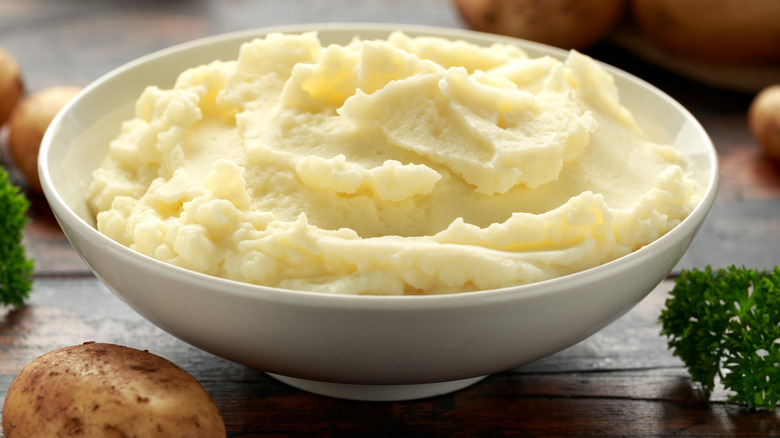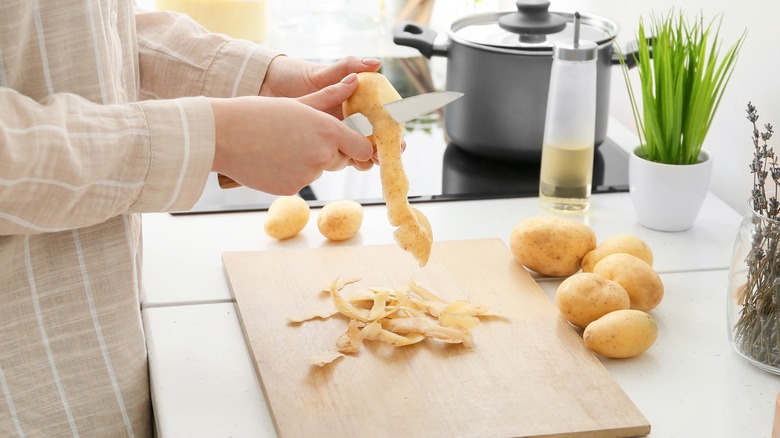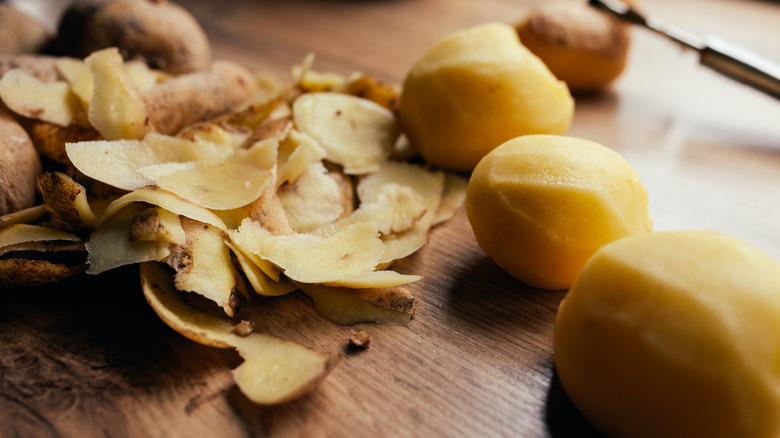How To Level Up Your Mashed Potatoes With Leftover Potato Peels
With the holidays fast approaching, many home cooks wonder how they can make familiar family favorites even better than last year. Maybe you'll finally fry the turkey this year, or make cranberry sauce from scratch. One timeless classic that never disappoints, but warmly welcomes upgrades, is mashed potatoes. Piled on your plate and smothered in gravy, they help you pick up every last delicious morsel on your plate and contribute to that happy, full belly feeling — boiled potatoes are the most satiating food after all (per National Library of Medicine).
While sometimes mashed potatoes can technically be made from processed, packaged flakes, the real deal is made with fresh, boiled potatoes. The texture is a matter of preference, as some like chunkier mashed potatoes, and others prefer a smoother eating experience. But copious amounts of butter is pretty much mandatory. Unfortunately, when many people make homemade mashed potatoes, one of the best parts of the root veggie gets relegated to the trash or at best, the compost bin, but using it will add a new dimension to this crowd-pleasing side dish.
Mixing potato peels into your mashed potatoes
A simple hack for upgrading your mashed potatoes is to work in the removed peels. First of all, do potato peels really belong in your mashed potatoes? Some recipes call for peels off for a creamier result, while others go skin-on for more of a hearty, potato salad-type texture. Australian Broadcasting Network reports via potato farmer Simon Moltoni that potato skins contain vitamin C, vitamin B, fiber, and potassium and that he prefers the texture and flavor of unpeeled potato dishes. Potato skins are also high in folate and vitamin B6, and keeping them on the potato is the best way to retain all these nutrients during cooking, Healthline reports.
If you prefer to peel your potatoes, you may be able to use them still, just watch your timing. Food Network warns that if you peel your potatoes ahead of time, anticipating a busy holiday in the kitchen, you might wind up with oxidized potatoes that are about as enticing as brown apples — caused by a similar reaction and just as harmless. Soaking the whole potatoes in water in the fridge protects them from this but you can't keep them there too long, they'll only be good for about a day.
Spiff up your spuds
Now that your potatoes have been skinned, don't throw them out. They may not look capable of transforming a classic dish, but they'll enhance flavor and texture even if you've opted to leave them out of the mash itself. Bon Appétit editor Zaynab Issa slices the skins thinly and fries them in extra-virgin olive oil and unsalted butter until they're potato-chip-like. These crisps are in themselves a viral phenomenon, as TikTok reveals, but before you snack on them all, there's another great use for the.
Issa pours the browned, buttery oil from the pan into her mashed potatoes and whips them into a dreamy consistency before taking those potato skin "cracklings" and tossing them on top of the dish to serve. The result is a rich and creamy mash with crunchy, earthy potato peel sprinkles.
Issa reveals to Bon Appétit that it was a common Thanksgiving problem that sparked the idea. She says, "I feel like one of the biggest problems with mashed potatoes on Thanksgiving is lumpy versus creamy mashed potatoes." But she didn't want to follow the usual mashed potatoes hacks, she states, "I wanted to come up with something that I hadn't seen anywhere else."
By using your potato peels, you're not just creating a rockstar recipe, you're participating in the reduction of food waste, which the United States Department of Agriculture estimates at between 30-40% of our food supply or hundreds of billions of pounds yearly.


